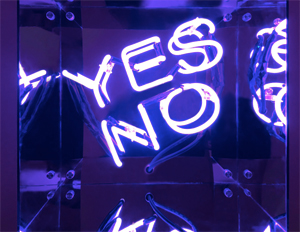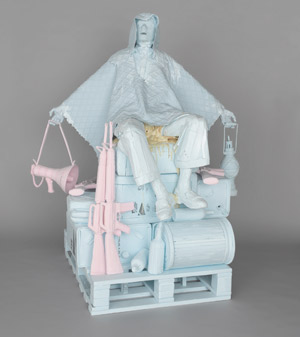Hung Jury
John Haberin New York City
Hudson Valley MOCA and the Straus Collection
There are hung juries, and then there are juries in charge of hanging art. Both can frustrate those in search of a verdict, and so does the first annual juried show at Hudson Valley MOCA. Still, it took me up the Hudson on a glorious summer day—to Peekskill, with a waterfront park by the train station and a museum new to me about a mile into town. I found, too, scenes of a bruised and fallen humanity in sculpture from the Straus collection, as "Death Is Irrelevant."
By definition, juried shows preclude a curator's vision, which only adds to the frustration of large group shows. They can allow for serendipity, and they can, no doubt, claim a greater objectivity than a single voice. Still, they are just as likely to conform to whatever the art scene takes for granted these days—but without highlighting it, demanding it, playing with it, or questioning it. As a regular event, an annual has problems of its own as well.  Does the world really need another biennial or triennial, only more frequent? Does it need another contribution to feeding frenzies over emerging artists and the latest thing?
Does the world really need another biennial or triennial, only more frequent? Does it need another contribution to feeding frenzies over emerging artists and the latest thing?
Juried shows are also largely the province of low-tier galleries and artist collectives, and you can see why. Curators have careers at stake, and a little outrage or a major gamble never hurts. In contrast, juries and collectives are likely to be mutually self-affirming. Besides, the alternative is to look for votes on any submission from anywhere, producing even more chaos. And HV MOCA does have artists from well beyond the Hudson Valley. The welcome surprise is how often they offer a fresh take on expected.
The jury is still out
One expects, of course, diversity, and more than half the twenty-two artists are women. Nor are women the sole Latinos and African Americans. I cannot swear to the presence of LGBTQ art, but Chin Chih Yang sure camps it up for Earth Day. One can catch him on video, across from the actual jacket that he wore to Times Square, with enough glitter to put Elvis to shame. Disability, too, has a place—or perhaps the refusal to call autism a disability. A swirling portrait by Gabriel Adames brings a light touch to the style of street art.
One expects fabric as well, as testimony to diversity or as a medium akin to painting. Desmond Beach adopts it to demand an Insurrection, in a circle that recalls a sewing cushion in African or American tradition. Sarah Sharp declares her Kinship in tassels that bring her otherwise black tapestry closer to the everyday. Anne Samat adds beads and more to loose thread in a concurrent solo show upstairs. It takes on human form, like Native American hangings for Jeffrey Gibson, as an empty suit or a totem. With her roots in South Asia, Samat could be the thrift store version of Mrinalini Mukherjee.
In other words, one gets what one expects, but is that enough? It all comports with the explosion of painting today, given that the fabric hangs flat on the wall. Like the art fairs, it scants photography and new media, and conceptual art seems all but a thing of the past. What, then, can an annual add to a biennial or triennial? HV MOCA even restricts the show to a month in summer, like a place holder or an afterthought. Every so often, nearby works play against one another, like flattened cardboard boxes for John Mucciolo and their image in photographs by Linda Lindroth, but not often enough.
Already, though, one can see the personal behind the ostensibly political. Collaged silhouettes as an assertion of black identity by Jennifer Hoffman-Williamson look awfully familiar, but not the "unknown" African American woman seemingly behind wallpaper in a photo by Carmen Lizardo. Jodie Goodnough has her photos of wallpaper, too—or rather stark interiors in homage to "The Yellow Wallpaper" by Charlotte Perkins Gilman, a short tale of horror or madness that has become a feminist classic. The nude with a fish by Bony McQueen seems too vulnerable to send a message as well. So does the woman pierced by surgical rods in the wild geometry of a prison-like interior, by Erin Juliana. So, too, do the sad sculptural head in lava by Adrian Rivera and a patently silly face in a landscape from Stanley Zabar.
Fabric and the urban experience come together for Charles Mason III, for whom a crumpled hoodie becomes a dark relief—and in a dizzying streetscape in tapestry by Natalya Khorover Aikens. Indira Cesarine picks up the neon opposites of Glenn Ligon, in her case Yes / No, but as a woman. And indeed she calls their mirrored frame her Pandora's Box. Then again, "You Don't Have to Be Black to Feel Outraged," according to the protest sign in a photo by Ocean Morisset. After the outcry that sought to deny Dana Schutz her outrage at the death of the death of Emmett Till, I can almost overlook that its aging white male looks little more than a selfie. They might all claim to represent, like an American flag in a neat bow by Marcy Freedman, My Country Now.
The current return to Minimalism puts in an appearance with Ellen Weider and her architecture of colored squares—and with a curvy ladder with C-clamps by Steve Rossi. Mela M. even adapts it to show the Indomitable Spirit of the Amazon, in stacked panels that become sculpture on the floor. Still, who will play the role of curators and midlevel galleries in nurturing a future for art? Can a small museum up the Hudson, just when wealthy galleries and museums are expanding into a cross between theaters and shopping malls? The jury is still out.
In sorrow or in anger
Busts of a man and woman, flaunting their bourgeois piety, face off at a discomforting distance. A man in filthy work clothes, head in hands, keeps to one end of a park bench. A nude, his arms left unfinished or violently cut off, slumps back, unconscious or dead. You do not want whatever still another man is smoking. They and half a dozen others share a crowded platform in a back corner of the museum, in sorrow than in anger. Is this all that is left of a common humanity?
One might think so, in a show spanning seventeen countries and forty years of contemporary art. I have already mentioned work by Paloma Varga Weisz in Germany, Mark Manders in the Netherlands, Pawel Althamer in Poland, and Red Grooms in the United States. They suggest a single common denominator more that civilization as we know it has papered over. At the same time, they flaunt their stereotypes, like those of limewood sculpture for Weisz and pop culture for Grooms, who makes all his art from its scraps.  Should I be laughing or crying, and would I be doing so with them or at them? They suggest a welcome ambivalence at the heart of some notably pretentious art.
Should I be laughing or crying, and would I be doing so with them or at them? They suggest a welcome ambivalence at the heart of some notably pretentious art.
Does the raised platform look like a receptacle for a trashed exhibition? The sculpture remained on view after its official closing date, and it may have had to give way to the museum's first annual juried show. Still more stays put for a while in galleries all the way across the floor. It belongs to the Marc and Livia Straus collection—as curated by Ken Tan, the private dealer, and Tim Hawkinson, the artist of primitive men, nail clippings, oversized testicles, and cast-metal feet. Marc Straus has his own gallery with a much wider point of view, including that of Charles Hinman and Jeanne Silverthorne. Here, though, he and his wife, who also founded HV MOCA, call attention to a more coherent movement than I ever expected.
Kiki Smith is by no means the oldest artist, and her papier-mâché self-portrait is by no means among her earliest works. Still, she did much to kick things off with her sorrowful Post-Minimalism. Was she repudiating her father, Tony Smith, and his geometric abstraction? Maybe, but she often shares his black, and he did call a massive cube Die. By shrinking into themselves, low to the floor, her female figures also call attention to their surrounding space, much like her father's Minimalism. Like Minimalism, too, they leave little room for irony.
Sam Jinks gets in his digs at myth, both past and present, with a modern-dress Pietá. An enthroned figure by Folkert de Jong would look far more dignified without his megaphone and assault weapons. A corporate suit lying face down, handcuffed behind his back, by Olav Westphalen, gets no more than he deserves. Claudette Schreuders gives her female adult nudes the dissonant scale of children. And when Tony Matelli calls his figure Ideal Woman, you can be sure he means anything but. One may remember this art as larger than life, but Smith's raw feelings still shine in the handmade surfaces of Nicole Eisenman, Rona Pondick, and Rebecca Warren (not coincidentally, all women).
One may remember it all, too, as hyperreal, and Evan Penny takes care for skin's every blemish and every pore. Matt Johnson shapes his anatomy from loaves of bread. How, then, can the show's title claim "Death Is Irrelevant"—and how can the curators then quote the Tibetan Book of the Dead, to the effect that "death is a mirror in which the entire meaning of life is reflected"? Has death given way to an eternity of suffering, as for Huma Bhabha, or the eternal present tense, in what Althamer calls The Power of Now? When I came to an enormous totem by Manders back in New York, in 2019 summer sculpture, I lost patience with his sentiment. Yet he had the honesty to let it fall to earth.

The first annual juried show at Hudson Valley MOCA and "Death Is Irrelevant" ran through September 8, 2019. Marc Straus reopened on the Lower East Side for fall that very day. A related review looks at a collector with museum aspirations, in Faurschou New York.




